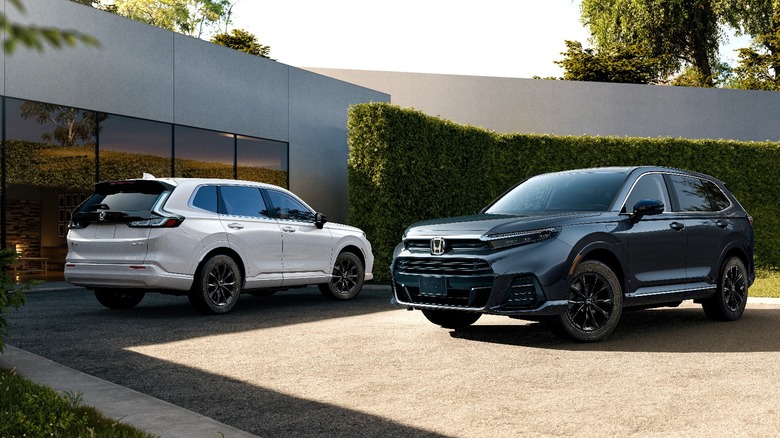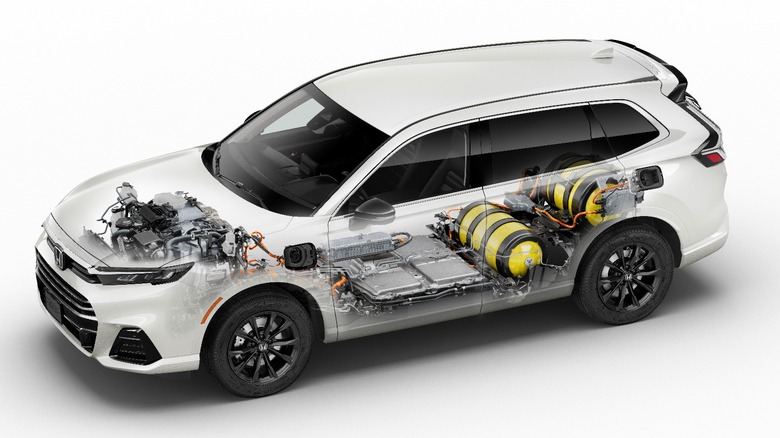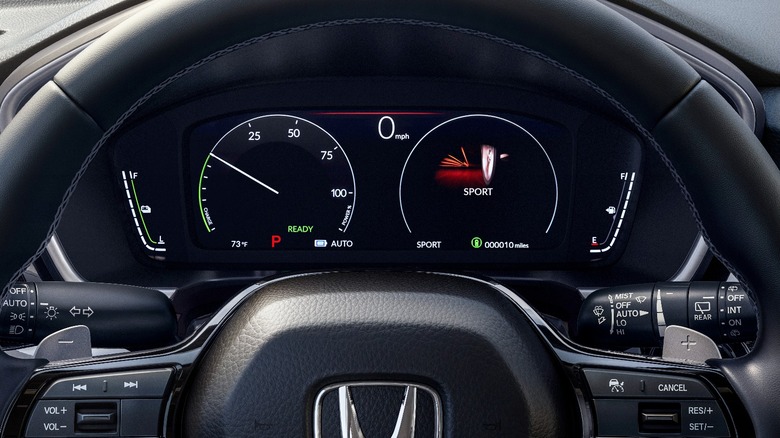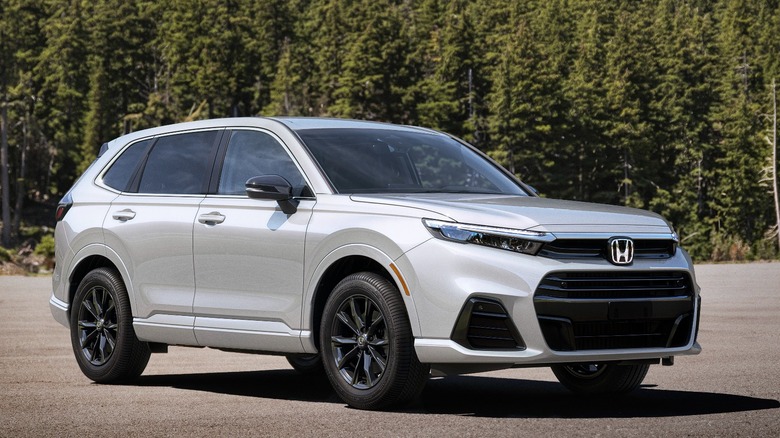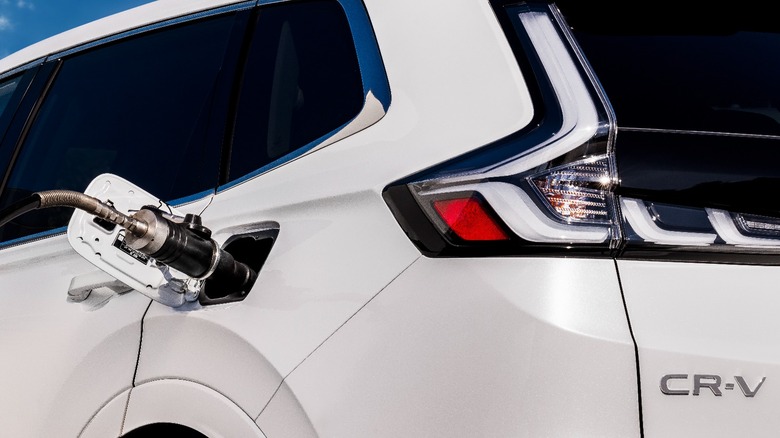5 New Honda CR-V Features To Be Excited About
The Honda CR-V is one of the best-selling small SUVs in the world, with the comfortable roundabout vehicle getting the top three position in 2023 after selling over 700,000 units globally. This model helped make Honda one of the top car companies worldwide, hitting seventh place in sales in 2023 after selling over four million units.
However, Honda's electrification strategy is controversial, especially as it only has one EV in its lineup: the 2024 Honda Prologue. This is a stark difference from some of its top competitors, who are now launching many EV models like Volkswagen, Hyundai, and Ford.
Nevertheless, Honda is slowly but surely moving into electrification and alternative fuel sources. We already have a hybrid version of the 2023 Honda CR-V, and we're now getting a plug-in version of this small SUV. However, this isn't the usual plug-in hybrid like the 2021 Toyota RAV4 Prime; instead, we're getting a plug-in fuel cell CR-V.
The e:FCEV option
In 2024, you only have one option for a hydrogen fuel cell car: the Toyota Mirai. However, it will soon be joined by a competitor in the 2025 Honda CR-V e:FCEV. This plug-in fuel cell vehicle is based on the top-trim Sport Touring Honda CR-V and will look and feel similar to its other non-fuel cell siblings.
This CR-V with a unique propulsion method is initially available only in California, where most retail hydrogen stations are located. Furthermore, you can only get it on a lease from Honda later in 2024.
Nevertheless, the CR-V e:FCEV has a vehicle-to-load feature, usually only in BEVs. According to Honda, "the included Honda Power Supply Connector utilizes a 110-volt power outlet that can deliver up to 1,500 watts of power, turning CR-V e:FCEV into a clean power source capable of running small home appliances, portable air conditioners, power tools, camping equipment, and more."
A unique front fascia and rear lights
Since the CR-V e:FCEV is based on the regular and hybrid CR-V, it has similar looks and almost the same dimensions. The new compact SUV receives an updated front fascia, giving it a more prominent front grille and a slightly longer front overhang. You also get clear taillights instead of the usual red lenses, providing the e:FCEV a cooler look.
Its interior is virtually the same as the Touring trim it's based on, except it's missing the sunroof. However, while the interior passenger room stays the same, you must compromise in cargo space as the hydrogen tank takes up a big chunk of space in the back.
As for the tech and goodies, you won't miss out on anything. It has everything, including the complete Honda Sensing Package with the Blind Spot Information System and Cross Traffic Monitor, which is optional in the base LX trim. You also get wireless Android Auto, wireless Apple CarPlay, and a 12-speaker Bose sound system for the ultimate comfort and convenience on the road.
29-mile battery only range
One of the biggest advantages of plug-in hybrids is that you can practically use them in EV mode. According to research by Hannah King of UCLA, the mean commute distance of higher-income Americans in 2017 was 13.7 miles. Title Max reports that this distance takes around 28.1 minutes daily.
So, the CR-V e:FCEV's 29-mile EV-only range should be more than enough for the one-hour drive from the house to the office and back for most drivers. Furthermore, this car can use California's HOV lane, even if only the driver occupies it, further reducing the commute time.
However, even if the 29 miles is good enough for daily use, this is low compared to the best plug-in hybrid SUVs, where the worst EV-only range is 33 miles for the 2023 Kia Niro PHEV while you can get up to 49 miles from the 2023 Jeep Wrangler 4xe. Of course, all these other vehicles have a gasoline-powered internal combustion engine that takes over once you run out of juice. On the other hand, the CR-V e:FCEV uses something a bit more different.
270 miles with zero emissions
Although the CR-V e:FCEV has a battery, its primary fuel source is the hydrogen in its tanks, which interacts with oxygen to produce electricity that drives the motors, and its only by-product is water. Unfortunately, the CR-V e:FCEV only has a 270-mile range on a full tank of H2 and a topped-up battery, less than half the range of the front-wheel drive CR-V Hybrid at 560 miles for 14 gallons (518 miles for the AWD variant).
Nevertheless, the main point of the CR-V e:FCEV is that it has no emissions. Unlike hybrid cars, which automatically use the internal combustion engine when the car's small battery runs out of juice or if it hits a certain speed, or plug-in hybrids, whose zero-emission range is often less than 50 miles, this small SUV only emits water throughout its entire range.
While some would point out that creating and transporting hydrogen is energy-intensive and could lead to more carbon emissions, new technologies are being developed to reduce this significantly. Furthermore, Honda is also researching the feasibility of a hydrogen fuel cell truck in the US, further reducing the carbon footprint of hydrogen fuel.
Refill your car in five minutes (and for less)
The biggest advantage of a hydrogen fuel cell car is how quickly it takes to refill the tank. While battery technologies continuously improve, fully recharging an EV takes a lot of time. For example, the Hyundai Ioniq 6, which topped our list of fastest-charging EVs, takes 25 minutes to get a full battery.
On the other hand, you can refill the Toyota Mirai, which has a 5.6 kg capacity and a 402-mile range, in just five minutes. Since the CR-V e:FCEV only has a 4.3 kg hydrogen tank, fueling the SUV should take even less time. Even if the Ioniq 6 gets 868 miles per hour of charging, you can theoretically get 3,240 miles per hour of refueling with the plug-in fuel cell CR-V, thus making it more convenient (if a hydrogen station is near you).
Furthermore, the high energy density of hydrogen means it's more fuel-efficient than hybrids. The 2024 Honda CR-V Hybrid FWD gets a combined EPA rating of 40 MPG, while the AWD version gets 37. On the other hand, the e:FCEV gets a combined rating of 57 MPGe, making it almost 50% more efficient. TechCrunch also reported that Honda will subsidize the hydrogen fuel for the CR-V e:FCEV, making it a more attractive option for those in the market for a fuel-cell car.
